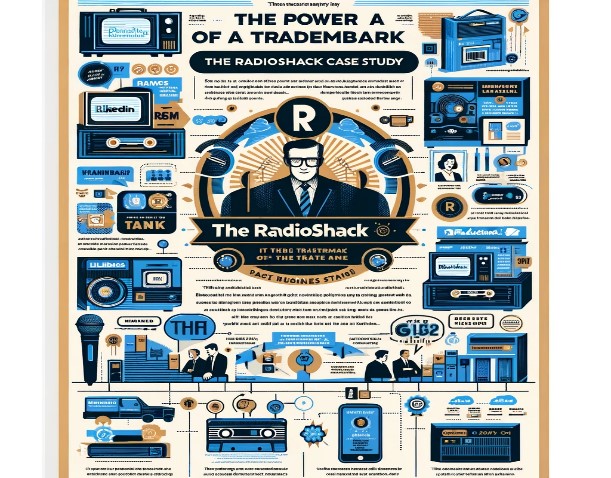Trademark Strategies for Business Growth: Unlocking Brand Power

Trademark Strategies for Business Growth: Unlocking Brand Power

Introduction: In the fierce arena of modern business, a strong brand is not just an asset; it’s a weapon. Trademarks, the legal embodiment of a brand, are often underestimated in its power to drive growth and establish market dominance. This article delves into strategic approaches to leveraging trademarks, turning them from mere logos into cornerstones of business growth.
- The Power of a Trademark: Trademarks are not just about protecting a name or a logo; they are about capturing the essence of a brand and its promise to consumers. A well-crafted trademark can convey trust, quality, and distinctiveness – all vital elements in today’s competitive marketplace.
- The Power of a Trademark: The RadioShack Case Study.
Trademarks hold immense power in the business world, serving as more than just legal protections for a name or logo. They embody the reputation, quality, and identity of a brand. To understand the true value of a trademark, let’s delve deeper into the case of RadioShack, a brand that has navigated the turbulent waters of the retail electronics market.
- RadioShack: A Legacy Brand: RadioShack, once a household name in electronics retail, offers a compelling story of how trademarks can retain value even as businesses evolve. Founded in 1921, RadioShack became synonymous with consumer electronics, hobbyist components, and personal service. Its trademark became a mark of accessibility and variety in electronics.
- Brand Recognition and Loyalty: The RadioShack trademark represented a legacy of innovation in consumer electronics. For generations, it was a go-to place for electronic components and gadgets. This recognition wasn’t just about the products but also the brand experience – knowledgeable staff, a community feel, and a sense of exploration. The trademark thus encapsulated customer loyalty and trust built over decades.
- Trademark as a Business Asset: Even as RadioShack faced financial challenges and market shifts with the rise of online retail, the value of its trademark persisted. When a company undergoes restructuring or sale, its trademark is often one of the most valuable assets. For RadioShack, the brand name and trademark continued to hold significant value, attracting business ventures and investors interested in capitalizing on the brand’s legacy and widespread recognition. In May 2015, the company’s assets, including the RadioShack brand name and related intellectual property were purchased by General Wireless, a subsidiary of Standard General, for US$26.2 million[1].
- The Role of Nostalgia: In the case of RadioShack, nostalgia plays a crucial role. The brand evokes memories of a bygone era in electronics, which can be a powerful tool in marketing and brand strategy. Leveraging this nostalgia, the RadioShack trademark can be used to tap into a segment of consumers who have a fond connection with the brand, offering opportunities for revival and reinvention.
- Rebranding and Adaptation: RadioShack’s journey also underscores the potential for rebranding and adaptation. A well-established trademark like RadioShack provides a foundation upon which a business can pivot or reinvent itself, exploring new markets or business models while maintaining a connection to its heritage.
- The Enduring Power of a Trademark: The RadioShack example illustrates that the power of a trademark extends far beyond its legal status. It represents a brand’s history, its relationship with customers, and its potential for future reinvention. In the ever-changing landscape of retail and technology, the RadioShack trademark stands as a testament to the enduring value a well-established brand can hold, even in the face of market turbulence.This case study demonstrates why businesses should not only protect their trademarks but also nurture them, understanding that they encapsulate the essence of the brand and its relationship with consumers, both of which are invaluable assets in the corporate world.
- Establishing Brand Identity: A trademark is the first step in establishing a strong brand identity. It differentiates your products or services in a crowded market, creating a lasting impression on consumers. Think of the most iconic brands in the world – their trademarks are instantly recognizable symbols of trust and quality.
- Legal Protection and Competitive Edge: Trademarks provide legal protection against imitation and counterfeit. By registering your trademark, you gain exclusive rights, preventing others from using similar signs that could confuse customers. This legal shield not only protects but also empowers businesses to take action against infringements, safeguarding their market position.
- Expanding Market Presence: Trademarks can be a key driver in expansion strategies. They can be licensed, creating new revenue streams without significant investment. Moreover, a strong trademark can pave the way for collaborations and partnerships, opening new markets and opportunities.
- Enhancing Business Valuation: In mergers and acquisitions, trademarks often account for a substantial part of a business’s valuation. They represent not just the current value but also the future potential of the brand. For startups and SMEs seeking investment, a registered trademark can significantly boost investor confidence.
- Building Customer Loyalty: At the heart of a successful trademark strategy is the ability to build and maintain customer loyalty. A trademark that resonates with consumers can lead to higher brand loyalty, repeat business, and ultimately, a stronger bottom line.
- Strategies for Maximizing Trademark Potential
- Conduct Comprehensive Research: Ensure your trademark is unique and resonates with your target audience.
- Think Globally: If international expansion is in your plans, consider trademark protection in key markets.
- Monitor and Enforce: Vigilantly monitor the market for potential infringements and enforce your rights to maintain the integrity of your brand.
- Innovate and Evolve: Keep your brand and trademark relevant by evolving with market trends and consumer preferences.
Conclusion: Trademarks are more than legal formalities; they are powerful tools for business growth. By understanding and strategically leveraging your trademark, you can unlock the full potential of your brand, driving growth, and securing a competitive edge in the marketplace.
Need help overcoming IP challenges? Contact Emmanuel Coffy at [email protected] or call (973) 996-2947 to see how we can help. You can also visit our website www.coffylaw.com.
If you wish to receive future articles, follow me on LinkedIn or send an email to [email protected] with your contact information indicating you wish to receive future articles.
For SMEs looking to dive deeper into the patent process, our upcoming workshop offers hands-on guidance from experienced IP professionals. Secure your spot today and take the first step towards protecting your tech innovation. Stay ahead in the game of IP protection – register now! https://www.coffylaw.com/live-seminar-signup/
For a free eBook activate the link below.
https://www.coffylaw.com/ebook-request/
© 2024 COFFYLAW, LLC – All rights reserved


